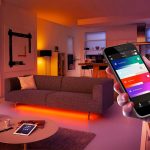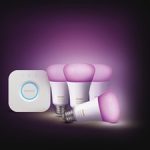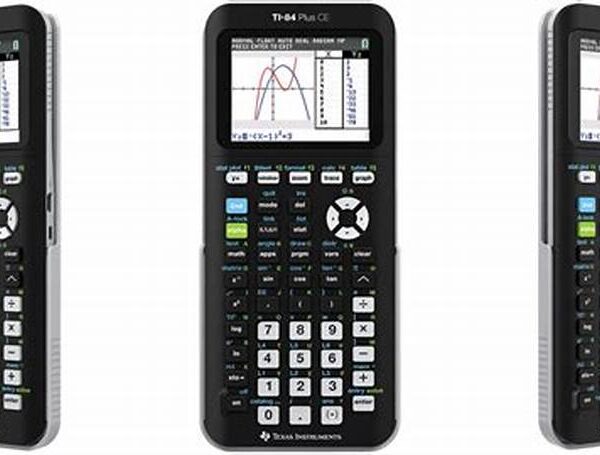Newlintech welcomes you to our Philips Hue Smart Light review and guide, where you can decide whether this is the smart light system for you before Amazon Prime Day deals in 2021 when we expect some pretty impressive discounts across the Hue range. The Philips Hue range has just won Best Smart Lighting at our Awards 2021, again proving its dominance in the smart lighting sector.
In this article, we’ll explain everything about Philips Hue smart lights, how they work, and whether you should buy them. We explore Philips Hue’s parent company Signify’s smart lighting system and our thoughts on its hardware.
Table of Contents
OVERVIEW OF PHILIP HUE SMART LIGHT
Smart lights are available as standalone lamps or as bulbs you can install in existing fixtures if you’re new to the idea. As they’re connected to Wi-Fi, they can be controlled with an app as well as regular light switches, turning on and off as normal.
It means you can turn on or off, and change the color and brightness of your lights with a tap on your phone or tablet. Using those foundations, you can go even further, by setting up lights that turn on when you enter the house, grouping them together, or even scheduling them.
This is all possible with Philips Hue smart lighting. You can choose from an extensive selection of bulbs and lamps, and the lights are simple to set up and use, as well as provide access to plenty of advanced features. With this smart lighting system, your life will never be the same.
Signify’s standard bulbs deliver the same brightness as a 60W incandescent bulb while using only 10W of electrical energy (thanks to the LED). They’re also guaranteed to last for at least ten years.
The Hue lights are also compatible with Amazon Alexa, Google Assistant, Apple HomeKit, as well as Samsung SmartThings.
No matter what smart home system you choose, Philips Hue will work with it, which is another reason it’s one of the leading names in the business.
PHILIPS HUE SMART LIGHT NOW SUPPORTS BLUETOOTH
Philips Hue bulbs have been discussed below, but the latest lights released under the brand name are different from all the ones before them: they can be controlled both over Bluetooth and over Wi-Fi.
You now have a Hue bulb that can work without a Hue Bridge (although the Bridge offers a few extra features, like the ability to control lights while you’re away.
There are only two Bluetooth-ready bulbs on the market currently, and both are available only in the US for now. Throughout 2019 and 2020, Signify plans to expand the offerings of its Bluetooth bulbs.
HUE BULBS AND ACCESSORIES FROM PHILIPS
One of the things that make Philips Hue products appealing is the sheer number of products available. One of the best places to start is with one of the starter kits, which comes with a Hue Bridge to connect to your router and a selection of bulbs.
In addition to Philips Hue Outdoor lights, we have a buying guide for those as well. There are Starter Kits available with colored B22 bayonet bulbs, white E27 screw bulbs, and colored GU10 spotlight bulbs with a dimming switch, for example. If you are buying lamps or lights, then you must decide the amount of money you should spend upfront.
You can also pick up the Philips Hue Bridge independently, if that is what you prefer, so you can buy whatever light fitting you wish with it. The Philips Hue Dimmer Switch we mentioned earlier, the Hue Motion Sensor, and the Smart Tap remote control are other accessories you can purchase.
Once your Hue Bridge and choice of accessories are installed, you will be able to add bulbs and sets of bulbs as needed. You can choose from the E27 screw, B22 bayonet, and GU10 spotlight bulbs, all of which have a white and a colored light option. A variety of colored and white E14 screw bulbs are available for smaller fixtures.
In addition to the LightStrips, Hue offers standalone lamps such as the Hue Bloom, Hue Play Colour, and Hue Play. Philips Lucca is an outdoor light option. The Hue Bridge allows you to control all of these lights using the Hue app or anything else you’ve connected to them.
Philips Hue Smart Light: SETUP AND INSTALLATION
Our earlier description of Hue emphasized the significance of the Hue Bridge in your world. The device is connected to your router through an Ethernet cable and can communicate wirelessly with up to 50 bulbs via a Zigbee-compatible network.
The Hue Bridge might seem a bit redundant since rival Lifx connects its bulbs directly to your Wi-Fi, but if you consider just how many gadgets are already trying to ping your router, it makes sense. It is entirely up to you how many smart bulbs you want to install and how much money you want to spend.
Adding bulbs and setting up the bridge takes just a few minutes. No experience is necessary: everything is handled via an Android or iOS app, and you can do so via the app as well. Once a smart light is scanned for in the app, you can push the button on the Hue Bridge and it appears on your network.
Add-on features such as Alexa and Google Assistant integration, or motion sensors can easily be added to the main network as well-each takes only a few minutes, and the apps involved guide you step-by-step through the process.
LIVING WITH PHILIPS HUE
With Philips Hue, you can get slick, reliable, and responsive smart lighting. Once you put a couple of Hue bulbs in place, you will be blown away at what’s possible.
After the major 2018 overhaul, the app is easier to use, especially since it took care of many little bumps and fixed a few bugs, including the way lights would come back on after a power outage at full brightness. Now, that doesn’t happen.
It’s a whole load of fun to play around with the Hue app and its timing, brightness, and color controls. With the Hue app, you can also group different lights together and this is intuitive. Philips Hue can be used by smart home pros or newcomers alike.
In the Hue Labs section, one area where Signify stumbles is in its experimentation with light. These methods include gradually fading up lights to match the sunrise, cycling through preset colors automatically, and turning lights on and off at random times (to try and trick potential burglars).
You need to spend a little more time working with Labs features and configuring them, but it’ll be worth it in the end. Rather than keeping them in a separate part of the app, we’d like to see more of them integrated into the actual app.
Smart gadgets are becoming increasingly common in homes, which is great news for those of you who use Google Assistant and Amazon Alexa integrations: you can still use the Hue app, but you can also use these digital assistants to turn smart bulbs (or entire rooms) on or off using voice commands. No matter where you are, all of this will work.
You can set scenes to help you focus, read, or find your way to the bathroom at night; your bulbs can automatically turn on in the morning or turn off after a set time in the evening, and a Hue app lets you sync lights to movies and video games.
You can easily do the simple stuff, and you can take advantage of advanced features-timers, groupings, and automation if you need them. It’s hard to see how the Philips Hue system could improve much, other than adding Hue Labs features to the main app.
| Pros | Cons |
| It works with multiple smart home standards. | Hue Labs needs some work. |
| Easy setup and configuration | It can be pricey. |
| Good choice of white and colored bulbs. |
VERDICT: Philip Hue Smart Light
This review has talked a lot about the advantages and appeal of Philips Hue lighting, so it’s only fair to point out some of its shortcomings as well. Depending on your needs, Ikea Tr*dfri is a better option than the Tr*dfri system.
As we’ve noted above, Lifx is Philips Hue’s main competitor. Additionally, these bulbs are not compatible with Hue Bridges; you can link them straight to your router instead. If you’re only interested in setting up a few bulbs, you might want to look into Lifx.
However, Philips Hue’s comprehensiveness and feature set are hard to match there’s a wide selection of bulbs, lamps, and fittings to meet most scenarios, and they’re simple to set up and configure, and they work exactly as advertised. There are a number of third-party integrations as well.
Smart lights don’t suit everyone, but Philip Hue quite literally sets the standard for what a smart lighting system can be-how much fun and useful a product like this can be. Hopefully, Philips Hue will do something interesting in the future.








